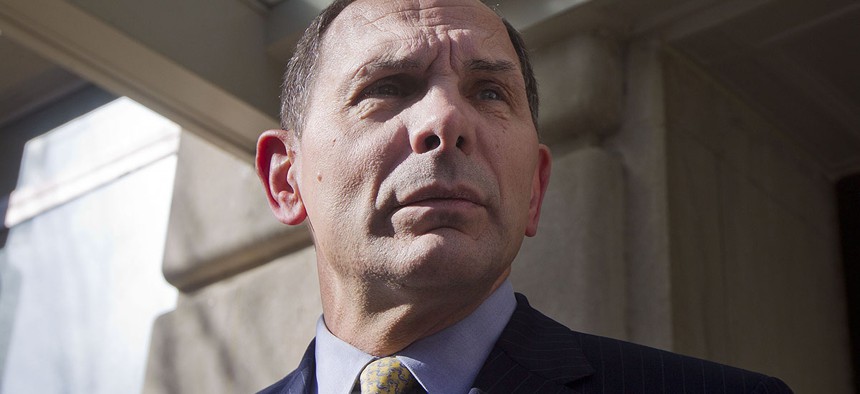Improving the Veteran Experience is (Literally) the Top Priority at VA

Veteran Affairs Secretary Robert A. McDonald speaks to reporters outside VA Headquarters in Washington, Tuesday, Feb. 24, 2015. Pablo Martinez Monsivais/AP
VA Secretary Bob McDonald announced 12 "breakthrough priorities" to Congress in early 2016.
Improving the veteran experience is at the top of the list of priorities for the Veterans Affairs Department.
Literally.
Displayed in the lobby entrance to VA’s Washington, D.C., headquarters is a large poster board emblazoned with the image of former President Abraham Lincoln and 12 “breakthrough priorities.” The poster board is signed by dozens of VA employees, signaling a renewed commitment – as Lincoln called for in his second inaugural address – “To care for him who shall have borne the battle.”
VA Secretary Bob McDonald announced the new priorities to Congress in early 2016, but work to improve the veteran experience began in earnest shortly after McDonald was confirmed by the Senate in mid-2014.
One of McDonald’s first major actions was hiring Tom Allin as the agency’s first chief veteran experience officer.
Allin, who previously served as the CEO of a large Asia-based foods company, brought private sector experience to an agency mired in national scandals, disability claims backlogs and bureaucracy.
“We excel in bureaucracy, and I’ll put our bureaucracies up against yours any day,” Greg Giddens, acting chief acquisition officer for VA, said Tuesday. “But the secretary came in and saw us as an organization that looked at ourselves from the inside out. He challenged us to think about how VA looks from the outside in, and how veterans look at VA. Veterans don’t see VA as an organization chart; they see it as an organization that is supposed to focus on their needs.”

VA may not yet be on par with customer experience stalwarts of the private sector like Amazon and Disney – very few federal agencies are – but VA officials say they’re on the right track.
VA recently launched a beta version of Vets.gov, a website site that intends to eventually give veterans single sign-on access to thousands of online services.
The single site is a response to the troubling confusion Allin said he experienced shortly after he was hired, when he learned VA has upward of 1,000 different websites pertaining to veterans’ needs. If a veteran tries searching on Google, “it’s just about impossible to get something done,” Allin said last August.
VA also began consolidating its 950 toll-free numbers to VA facilities and health centers to simplify the process by which veterans reach contact centers.
Additionally, VA is modernizing its approach to contact centers, striving for a “unified experience for veterans,” Giddens said, which means “collecting and securely sharing” the right data sets.
VA’s effort to improve the veteran experience has had other effects, too.
The disability claims backlog, which once topped 600,000, has been reduced to 75,000, its lowest rate since VA began measuring the statistic in 2009.
By the end of 2016, vets who enter a VA medical center will have their clinical needs addressed within the day, under VA’s new targets. Another goal is to provide veterans a faster decision when they appeal compensation decisions. Ninety percent should have an answer within a year.






